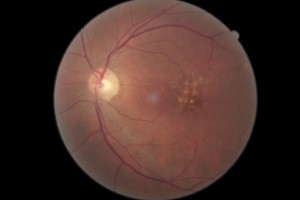| What is Macular Degeneration?

Age-Related Macular Degeneration (AMD) is a chronic disease of the central part of the retina, the macula. The macula is important for clear vision and color vision. Any change in the macula will significantly impair vision.
There are two forms of AMD:
Dry AMD is the most common form of AMD. It occurs when cells in the macula begin to break down, causing thinning of the macula and a gradual decrease in vision.
Wet AMD is much less common than dry AMD. It is caused by the growth of abnormal blood vessels in the choroid, which provides the blood supply to the retina. These new blood vessels grow into the macula through breaks in the membrane that separates the choroid from the retina. These weak blood vessels leak fluid into the retina, leading to a decrease in vision that is more rapid and dramatic than dry AMD.
Neither dry AMD or wet AMD causes total blindness, but it can decrease central vision profoundly. People with AMD may notice changes in their ability to read books, to see street signs or see details on a person’s face; fortunately they maintain peripheral vision and can walk and move around independently.
For more information about symptoms and treatments of AMD, click here
|